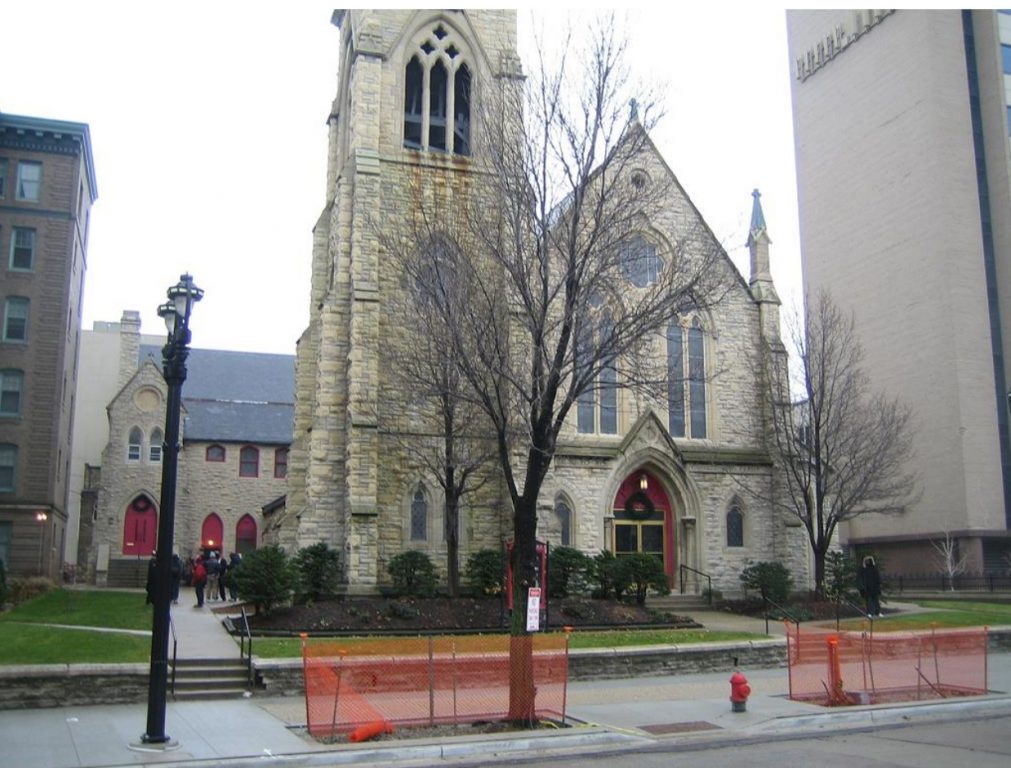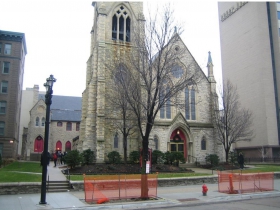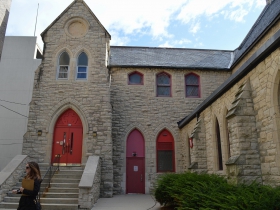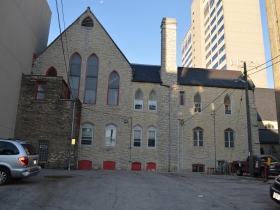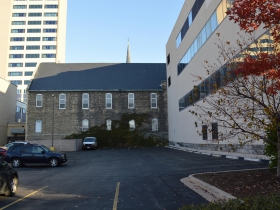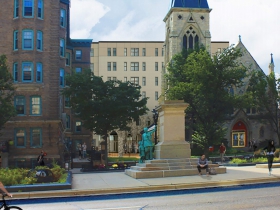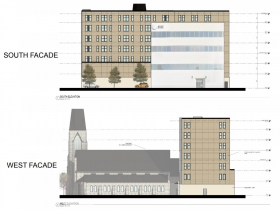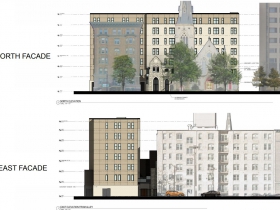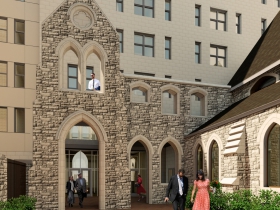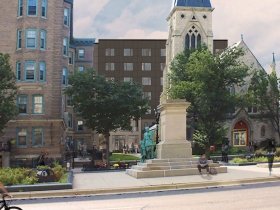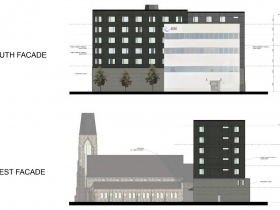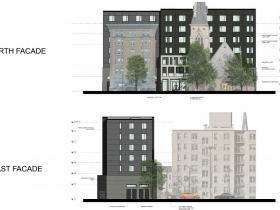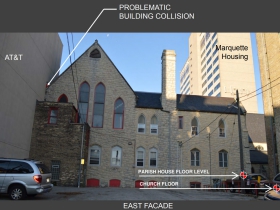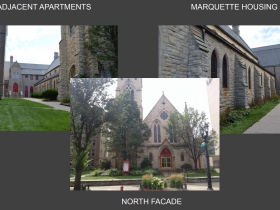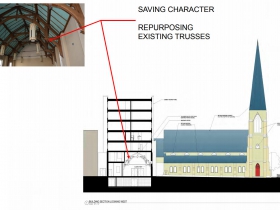Jeffers Saves Historic Parish House
Downtown church gets new lease on life from creative developer and state law change.
A small, but not insignificant, change in state law has saved at least one building in Milwaukee from demolition. But only after years of the state and federal government modifying a pivotal historic preservation program.
Developer Joshua Jeffers had originally proposed to demolish the parish house at the rear of St. James Episcopal Church in Westown as part of a complicated plan to convert the church at 833 W. Wisconsin Ave. into an event venue. The former church would have been combined with apartments and the reconstructed parish house hall at the rear of the site to create a large events complex.
Now he’ll save the parish house, built in 1899, thanks to a change to the state’s historic preservation tax credit program. But it won’t be cheap, nor easy, and it definitely won’t be immensely profitable for Jeffers.
“For us to convert the 1899 addition into something that is both historically accurate and built to modern code compliance, it would be enormously costly… This building has more asbestos in it proportionally than any other building I’ve seen,” Jeffers told the Historic Preservation Commission in December 2017. After months of meetings, one of which ended on a tie vote, Jeffers finally won support for his original proposal to partially demolish the parish house. Then things changed. He was back Monday afternoon to deliver the good news that he could save the parish house, and received a quick unanimous thumbs up from the commission for his $6.5 million project.
Commission chair Alderman Robert Bauman, who represents the area and voted against an earlier version of the deal, told Jeffers: “We should give you the man-of-the-year award for historic preservation.”
The venerable Protestant church, originally constructed in 1867, held its last service on November 1st, 2017, with the congregation folding at that time. The building, historically designated by both the city and federal government, had been listed for sale for a number of years with an asking price of $695,000. With dwindling membership, the congregation could no longer afford the expense of maintaining the large facility.
How To Do the Deal
What allowed Jeffers, who has preserved a number of historic buildings across town, to save another? Three things, says Jeffers.
The biggest driver is a change in state historic preservation tax credit law. The per-project cap on the 20 percent tax credit was increased from $500,000 to $3.5 million this spring. “It’s not the only reason we can make a lot of things work, but it’s the primary driver,” Jeffers told the commission.
The credits are often then sold by a broker to institutional buyers, but Jeffers found another way to save some money and make the project increasingly feasible. The prolific developer will keep the credits for his own firm, J. Jeffers & Co., thereby saving a couple hundred thousand more dollars in reduced transactional fees.
The third and final piece of the puzzle is investors willing to accept a reduced return for a good societal benefit – saving the historic building. Jeffers told Urban Milwaukee he found investors willing to risk their capital for a below-average return. All but one of the investors are local, and two are previous investors in Jeffers’ project. The developer credits Juli Kaufmann, who has developed a number of complicated, socially-minded projects across the city, for the inspiration for the financing model.
It’s been a summer of good news for Jeffers, who recently celebrated the completion of the Griot Apartments with co-developer Melissa Goins.
The New Plan
Keeping the parish house doesn’t mean the interior remains untouched. Yes, the hall on the second floor will be preserved as an event venue, saving Jeffers the cost of dissembling the hall and rebuilding it into the new building, but the rest of the building will be substantially gutted and rebuilt.
“It has asbestos and a really bad 1970’s church interior,” says Historic Preservation Commission staffer Tim Askin.
The hall, when paired with the sanctuary, will create two event venues in the same complex. “People spend gobs of money to get married in places like this, it’s a great business for a landlord,” joked Jeffers, who also owns the Grain Exchange Room in the Mackie Building. The rest of the parish house will be used as back-of-the-house support for the venues, including bride-and-groom suites and a kitchen.
The catering and events business will be led by Kate Crowle and Oliver Hunt of Hidden Kitchen MKE. Engberg Anderson Architects is still leading the design work on the project.
But what about the apartments that were included in the earlier plan? “We will find another place to put those apartments,” says Jeffers.
The developer intends to begin work this summer, with work wrapping up in January 2019.
For more background on the church and Jeffers’ original plans, see my column from November 2017.
Parish House Photos
Revised Plans Plans
These plans were approved, but are now obsolete.
Original Plans
If you think stories like this are important, become a member of Urban Milwaukee and help support real independent journalism. Plus you get some cool added benefits, all detailed here.
Political Contributions Tracker
Displaying political contributions between people mentioned in this story. Learn more.
- February 13, 2016 - Robert Bauman received $100 from Joshua Jeffers
Eyes on Milwaukee
-
Church, Cupid Partner On Affordable Housing
 Dec 4th, 2023 by Jeramey Jannene
Dec 4th, 2023 by Jeramey Jannene
-
Downtown Building Sells For Nearly Twice Its Assessed Value
 Nov 12th, 2023 by Jeramey Jannene
Nov 12th, 2023 by Jeramey Jannene
-
Immigration Office Moving To 310W Building
 Oct 25th, 2023 by Jeramey Jannene
Oct 25th, 2023 by Jeramey Jannene


